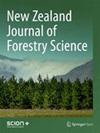Use of nitrogen-fixing plants to improve planted forest soil fertility and productivity in New Zealand: A review
IF 1.5
4区 农林科学
Q2 FORESTRY
引用次数: 0
Abstract
Background: Planted forests with low fertility soils are likely to require increased inputs of nitrogen (N) to satisfy increasing productivity demands. The use of N fertilisers will become more challenging due to their increasing cost and the risk of unwanted environmental impacts. Nitrogen-fixing plants may provide an alternative option to chemical fertilisers that is not only cheaper but has a lower greenhouse gas footprint. Methods: Information on N-fixing plants was collated from available literature, focusing on species previously associated with planted forests as well as other exotic N-fixing trees and New Zealand native plants not used in commercial planted forests. Results: Benefits to planted forest growth in New Zealand by N-fixing plants have been proven in only a few cases. Lupinus arboreus Sims was used in the 1970s and 1980s to increase N inputs in a planted Pinus radiata D.Don coastal forest, and improved P. radiata productivity was demonstrated. Productivity gains ceased when a blight disease infected the lupin population. Many N-fixing plants have been shown to tolerate low fertility soils and establish in planted forests, but there is limited information on their N contribution to the soil, and whether this N contribution increases P. radiata productivity. Such N-fixing plants include Lotus species, clover (Trifolium species) and weeds such as gorse (Ulex europaeus L.) and broom (Cytisus scoparius (L.) Link), which are commonly found in association with P. radiata forests. New Zealand native N-fixing shrubs may be suitable but there is limited information available describing N-fixation or forestry management for native plant species. Conclusions: Nitrogen-fixing plants are a valuable resource, which when managed properly could be used for enhancing productivity. Issues with pests and disease, and limited knowledge regarding the management of N-fixing species, restricts adoption in planted forests. Well-designed research is needed to assess impacts on whole forest system N cycling as well as selection of appropriate plant species for use in planted forests without unintended consequences such as competition for soil moisture or light. This research needs to be integrated with forest management and delivered as practical options to ensure success.利用固氮植物提高新西兰人工林土壤肥力和生产力:综述
背景:肥力低的人工林可能需要增加氮(N)的投入,以满足日益增长的生产力需求。由于氮肥的成本越来越高,而且有可能对环境造成不必要的影响,使用氮肥将变得更具挑战性。固氮植物可作为化肥的替代选择,不仅成本更低,而且温室气体足迹更小:方法:从现有文献中整理有关固氮植物的信息,重点关注以前与人工林相关的物种以及其他外来固氮树种和未用于商业人工林的新西兰本地植物:结果:固氮植物对新西兰人工林生长的益处仅在少数情况下得到证实。20 世纪 70 年代和 80 年代,Lupinus arboreus Sims 被用于增加人工种植的 Pinus radiata D.Don 沿海森林的氮输入量,并证明提高了 Pinus radiata 的生产力。当羽扇豆种群感染枯萎病后,生产力的提高就停止了。许多固氮植物已被证明能够耐受低肥力土壤并在人工林中生长,但关于它们对土壤的氮贡献以及这种氮贡献是否能提高黑松生产力的信息却很有限。这些固氮植物包括莲花品种、三叶草(Trifolium species)和杂草,如戈尔斯(Ulex europaeus L.)和扫帚(Cytisus scoparius (L.) Link),这些植物通常与辐射对称植物森林伴生。新西兰本地固氮灌木可能也适合种植,但关于本地植物物种的固氮作用或林业管理的资料有限:结论:固氮植物是一种宝贵的资源,如果管理得当,可用于提高生产力。病虫害问题以及固氮物种管理方面的知识有限,限制了人工林的采用。需要进行精心设计的研究,以评估对整个森林系统氮循环的影响,并选择适当的植物物种用于人工林,避免造成意外后果,如争夺土壤水分或光照。这项研究需要与森林管理相结合,并作为实用方案提供,以确保取得成功。
本文章由计算机程序翻译,如有差异,请以英文原文为准。
求助全文
约1分钟内获得全文
求助全文
来源期刊

New Zealand Journal of Forestry Science
FORESTRY-
CiteScore
2.20
自引率
13.30%
发文量
20
审稿时长
39 weeks
期刊介绍:
The New Zealand Journal of Forestry Science is an international journal covering the breadth of forestry science. Planted forests are a particular focus but manuscripts on a wide range of forestry topics will also be considered. The journal''s scope covers forestry species, which are those capable of reaching at least five metres in height at maturity in the place they are located, but not grown or managed primarily for fruit or nut production.
文献相关原料
| 公司名称 | 产品信息 | 采购帮参考价格 |
|---|
 求助内容:
求助内容: 应助结果提醒方式:
应助结果提醒方式:


